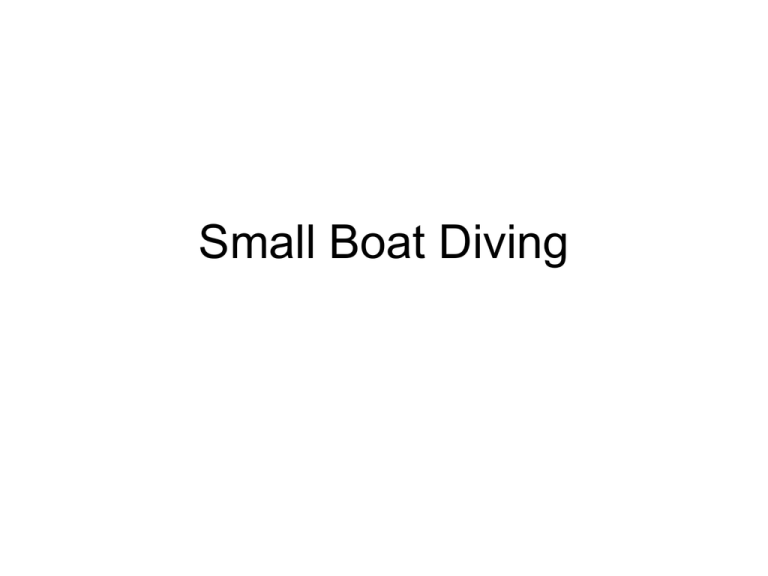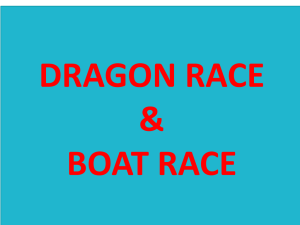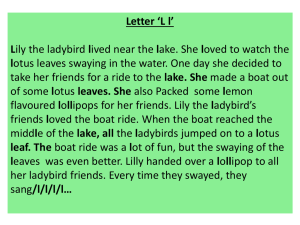Small Boat Diving
advertisement

Small Boat Diving Objectives • Identify the following areas of the boat: – Bow, stern, starboard side, port side • List the minimum safety gear required by the USCG. • Describe Procedures for launching and recovering a small boat from a beach. • Outline concerns and procedures for anchoring. • Discuss techniques for entries and exits from a small boat. • Describe techniques for diving in current. Main Topic Areas • • • • • • • • • Positives and negatives of small boat diving Terminology Safety Gear Loading Launching Anchoring Diving Beach Landings Emergency Procedures The Positives of Small Boat Diving • Small boats are excellent dive platforms – Allow us to reach sites otherwise not easily accessible. – Relatively economical. – Easily transported • Successful small boat operation and diving requires: – Planning – Boating skills – Teamwork The Negatives of Small Boat Diving • • • • Crowded space Possible sea sickness Time consuming Boat Issues Terminology • Bow – Front of the boat • Stern – Back of the boat • Port side – Left side of the boat as you face forward • Starboard – Right side of the boat as you face forward Safety Gear • Determined by the size of the boat • USCG requirements – USCG approved PFD for each passenger – “Throwable” PFD – Visual distress signals – Fire Extinguisher – Sound making device – Registration and hull numbers Safety Gear • Nice to have – First aid kit – Tools – Radio or other communication equipment Loading • Capacity Plate – Maximum number of passengers – Maximum total weight – Maximum size motor • Keep all cargo organized – Individual soft/mesh bags for divers • Keep the boat balanced Beach Launching • Position the boat with the bow toward the water • Locate the boat as close to the water as possible • Time the sets to enter on the calm period – Follow the last wave and let the water do the work – Get through the surf zone as quickly as possible Beach Launching • Hold the bow toward the waves – It may be necessary to paddle the boat away from the beach • Once in deep enough water – Lower the motor – Start the motor Anchoring • Ground tackle – Anchor Line • Typically nylon for strength and flexibility – Chain at the bottom • Protects against chafing • Acts as a shock absorber • Anchor Type – Select the correct anchor for the bottom type • Rock Anchor • Lightweight “Danforth” style • Scope – Ration of Length of Anchor line deployed to depth of water • 3:1 minimum • 5:1 preferred Anchoring • Anchoring Drill – – – – Allow plenty of room for swing Make a test run. Always lower the anchor. Never throw it. Make sure the anchor is attached, but can be slipped quickly. – Leave the engine running until you are sure the anchor will hold. – Pull back on the anchor to set it. Anchoring • Anchor bearings – Ranges to landmarks on the beach to establish position – Compass bearing to landmarks on the beach to establish position • Checking the anchor – Upon descent check the anchor to make sure it is set. – Prior to ascent, check the anchor to make sure it is clear to hoist. Anchoring • Hoisting anchor – Motor slowly up to the anchor. – Hoist being careful of your back. Diving Procedures • Entry into the water – Make sure the entry area is clear – Technique • Backwards roll • Sit and slide – Timing • Keep the boat balanced • Simultaneous entries from opposite sides • Alternate entries from opposite sides – Equipment management • Avoid entanglement • Gear up completely in the boat • Don your gear in the water Diving Procedures • Exit from the water into the boat – Technique • Ladder • Over the side – It may be necessary to enter over the stern of the boat » May be lower or more stable – Equipment Management • Do not remove any equipment until you are in contact with the boat. • Attach equipment to gear lines or have another diver hold onto the gear • Properly stow the gear as soon as you are in the boat. Diving Procedures • Current – Begin dive into any current – Deploy a current line for diver retrieval – Allow for the effects of current on air consumption – Use the anchor line for safety stops Diving Procedures • Liveboating – – – – Is vessel maneuverable enough? Is prop a hazard. Most boats drift bow down. Entering the water • Divers should exit the boat on the windward side – Pick up • Windward vs. Leeward side Beach Landings • Stop in deep water as close to the surf zone as possible. • Raise the motor • Time the exit to follow the last wave of the set – Divers are in the water ready to drag the boat up the beach • Boat orientation – Bow toward the beach – Stern toward the beach Emergency Procedures • Recall Procedures – Recall Signal • Racing motor • Banging metal together underwater – Diver Response • Make a safe ascent • Look to boat for signals Emergency Procedures • Radio protocols – – VHF Channel 16 is the emergency channel Levels of emergency • MAYDAY – • PAN (pronounced PAHN) – • Vessel is in imminent danger Potentially life threatening situation » Overdue or missing divers » Man overboard » DCS or AGE SECURITE (pronounced SAY-CUR-EE-TAY) – Hazards » Safety » Navigation » Weather Emergency Procedures – Info to transmit • Location • Boat identification • Type of emergency Emergency Procedures • Rescues – Strip gear prior to entering the boat – Enter at the most stable part of the boat • May be over the stern of the boat – Inflatable Boats • May have to partially deflate a pontoon Main Topic Areas • • • • • • • • • Positives and negatives of small boat diving Terminology Safety Gear Loading Launching Anchoring Diving Beach Landings Emergency Procedures Objectives • Identify the following areas of the boat: – Bow, stern, starboard side, port side • List the minimum safety gear required by the USCG. • Describe Procedures for launching and recovering a small boat from a beach. • Outline concerns and procedures for anchoring. • Discuss techniques for entries and exits from a small boat. • Describe techniques for diving in current. Summary • Proper utilization of small boats will significantly extend the range of your diving operations. • Successful small boat diving operations calls for proper planning, boating and diving skills and teamwork.







